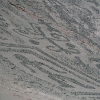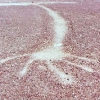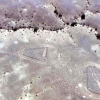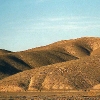Although the term rock art is commonly used to refer to petroglyphs and engravings on loose stones or on rock walls, it can also refer to markings created over extensive areas on the ground. Known as geoglyphs, these markings form huge images on flat tracts of land, on hillsides, on the walls of ravines and on terraces running along river courses. Three basic techniques are used to produce this kind of rock art: The arrangement of small stones that are lighter or darker in color than the ground below; the cleaning or removal of stones to leave lines or relief images on rocky ground; and a combination of these two techniques.
The smallest geoglyphs measure around three meters long, while the largest can reach over 100 meters in length. The most famous geoglyphs in the Americas are found at Nazca and in the southwestern United States. Images 1, 4. Less well known, but equally interesting, are the geoglyphs of the Atacama Desert, images 3, 2.
Many modern graphic techniques in use before the digital era ultimately derived from technologies invented by the prehistoric artists who produced rock engravings and paintings. The artistry of those highly skilled graphic artists, developed through four hundred centuries of experimentation around the world, laid the foundation for the emergence of the “image culture” that reigns in contemporary society today. In a certain sense, graffiti is a modern-day expression of these ancestral practices, while such recent artistic movements as Land Art were inspired by the old custom of creating geoglyphs on the landscape.








































